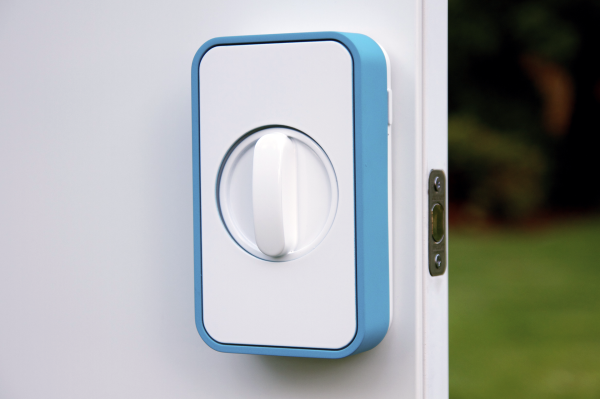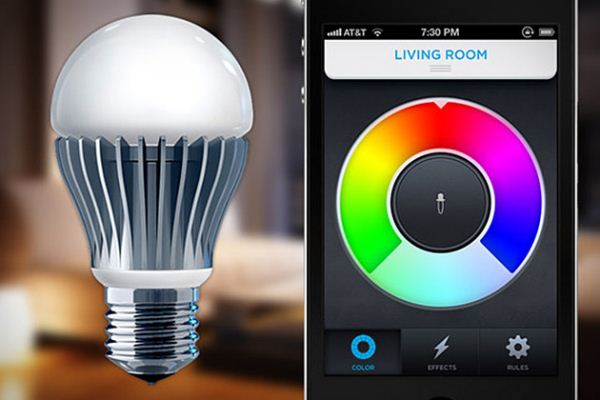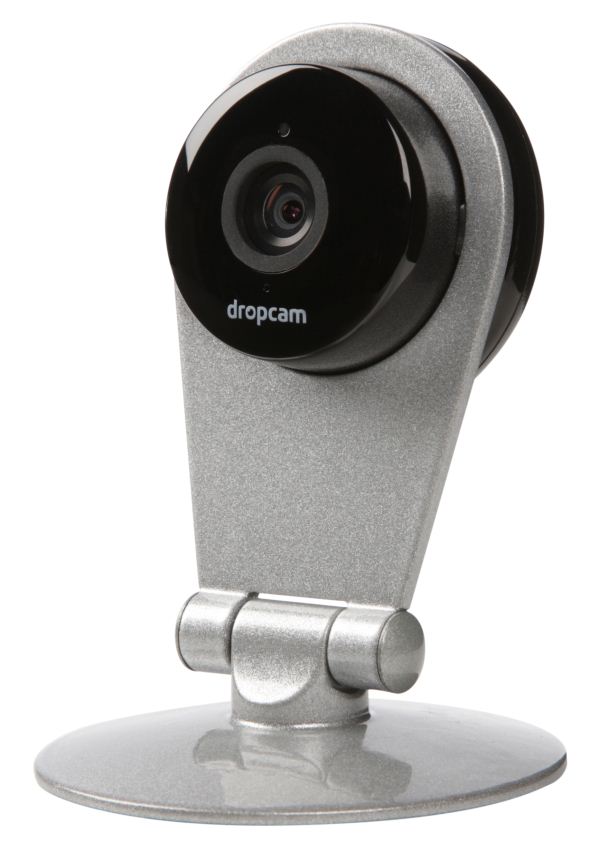Home Automation and the 'Internet of Things'
by Ganesh T S on October 4, 2012 10:30 AM EST- Posted in
- Gadgets
- Home Automation
- Wi-Fi
Crowdfunded initiatives have seen a sudden spurt thanks to the popularity of services such as Kickstarter and IndieGoGo. Since Wi-Fi is familiar to almost everyone with an Internet connection, crowdfunded initiatives involving Wi-Fi and the ‘Internet of Things’ have consistently been able to meet and even comfortably exceed their goals. The ease with which funding has been raised indicates the pent-up market demand for easy to use HA devices using infrastructure already in the hands of the consumers. In this section, we will take a look at some of the miscellaneous Wi-Fi enabled home automation devices which are already in the market / slated to appear soon.
Door Locks
Lockitron is a keyless lock which can be unlocked using a smartphone’s Wi-Fi, Bluetooth or NFC capabilities. It doesn’t replace the conventional lock, but fits over the existing one on the inside of the door while retaining the smartphone communication.
The product is expected to ship in March 2013. It is priced at $149 on pre-order. A mobile website / cloud backend ensures that any smartphone can control the unit, and it actually doesn't need to be connected to the local Wi-Fi network. The consumer doesn’t really need to be tied down to an iOS or Android device. Even older phones can access the unit using text messages. Importantly, the unit is based on the Atmel ATMega microcontroller, which is compatible with Arduino. Simple API endpoints are available, and users can also decide to program the unit themselves.
The LockState Connect LS-DB500i Wi-Fi deadbolt lock is another device slated to appear in the market soon. The company has a video of the unit in operation. Even though the device uses Wi-Fi, it seems to require only 4 AA batteries to operate (like other ZigBee / Z-Wave based devices). Battery life comparison will be quite interesting.
Lighting Control
Simple control of lighting equipment can be achieved through Wi-Fi power switches. However, some applications require dimming / brightness adjustment capabilities. National Control Devices offers a Wi-Fi light dimmer which provides up to 255 different brightness levels controllable over a Wi-Fi connection. However, with a total cost of around $380, it is targeted more towards industrial users rather than home automation. The ZigBee version costs around $320. Wi-Fi may not appear to be cost effective right now, but this doesn’t consider the external ZigBee router / controller needed for operation.
LIFX is one of the recent Kickstarter hits. The product is a Wi-Fi enabled LED light bulb. An interesting aspect to note is that only the master light bulb is Wi-Fi enabled to connect to the wireless network. The other bulbs communicate with each other and the master light bulb itself using a ZigBee 802.15.4 mesh network (which consumes much less power compared to Wi-Fi right now). However, the unit is quite costly, coming in at $69. As this market area garners more manufacturer interest, pricing will become better.
Alarms / Remote Monitoring with Wi-Fi : IP Cameras with Motion Detection
This is one of the classic use cases where Wi-Fi based home automation trumps any other low power alternative. Over the last few years, we have seen a number of Wi-Fi enabled IP cameras meant for surveillance purposes. At AnandTech, we have even reviewed some of them such as the Dropcam Echo, Compro IP70 and IP540. Technology advancements have reached a point where even 720p HD is available in IP cameras such as the Dropcam HD. Ease of use and control over Wi-Fi are some of the aspects that the manufacturers hope to get right in this market area. Almost all IP cameras can be configured to provide feedback based on motion detection (without an explicit motion sensor). Many of these devices can be controlled (Pan / Tilt / Zoom) using a computer or mobile app too.
Low power mesh networking technologies such as ZigBee and Z-Wave are simply incapable of the bandwidth required for video streaming over IP. In this situation, Wi-Fi (or wired Ethernet) is an option. As the control signals can easily piggy-back on the Wi-Fi / Ethernet connection, it really makes no sense to add ZigBee or Z-Wave capabilities to IP cameras. The only reason could be integration with an already existing home automation server, but, as we have taken effort to point out, the whole HA industry is slowly shifting towards a Wi-Fi centric model.













54 Comments
View All Comments
southpaw42_i - Thursday, October 4, 2012 - link
Electric IMP looks to become big Home automation over next few years.Product developer will be able to add HA WIFI features to their products without the needed support cost of a managing the connection and the service themselves or the FCC validation of each product..
http://electricimp.com/
ganeshts - Thursday, October 4, 2012 - link
Looks like a very interesting product. I will be sure to investigate.jamyryals - Thursday, October 4, 2012 - link
Thanks for the article Ganesh, very interesting and I agree that this technology is starting to get more accessible. However, I must disagree with the statement that it's not possible to recommend products that do not have a documented API. Nest works great for me standalone. Why would the average customer need to connect it to anything else? My sprinkler system is automated as well. It won't turn on if it has rained. The automated door locks will open when I approach with my cell phones. I think the simplicity and predictability in how these devices operate is key for mass consumer adoption.I am a developer so there's nothing technologically in this realm that has stopped me from automating my house in the past. It's practical matters; cost and me becoming on call support in my own house. Anytime the lights don't come on the way they are expected to I'll have to go troubleshoot my devices/scripts.
If we had our wish we would get both simplicity and ultimate control. That's just not the way the consumer behaves though. Consumers will avoid poorly designed products that tout open APIs as a major selling point. People want things that work and they can understand.
ganeshts - Thursday, October 4, 2012 - link
I don't disagree with you on the point that Nest is a great device. If it were not, it wouldn't have achieved this much success.Products such as Radio Thermostat CT-30 and those from Visible Energy barely make a mention of open APIs in their marketing material. So, it is not that they 'tout it as a major selling point'. My intention, as a tech journalist, is to point out where products can improve. In that respect, I am a cynical customer for most of these companies.
To take the computing analogue, many users are satisfied with the Apple ecosystem, but there are a number of users out there who stand by Android for its open nature. Some journalists recommend and stand by Apple's products, while others are on the Android side of things. Both of them have a place in the market. Similarly, devices such as Nest will be popular in the market for some time to come because 'they just work' and people are enamoured by the appearance and usability. Just as Android continues to grow, devices which open up for ultimate control will give consumers better choices (particularly for the tech audience that makes up a majority of AT's readers).
Publications like Engadget, Gizmodo, Verge, AllThingsD (WSJ) provide lots of attention to products like the Nest. As a tech journalist for AT, I consider it my job done if consumers are at least made aware of the other more flexible options available.
bobbozzo - Friday, October 5, 2012 - link
"Nest works great for me standalone. Why would the average customer need to connect it to anything else?"I'd like to have my house open the windows and turn off the A/C when the temperature drops in the evening, and I'd prefer to do it with one application. I can program, but I'd rather have something available off-the-shelf.
shalomo1 - Sunday, October 21, 2012 - link
I am currently working on a project about home automation, I would like to meet and share ideas with you. this is my mail abraham.o@aol.com. ThanksCSMR - Thursday, October 4, 2012 - link
Good to have an article on this.Unfortunate that if there's a conclusion, it's that WiFi will become a suitable technology in 2015 with 802.11ah.
Very little is even known about 802.11ah. It's too early to say what it is, let alone whether it will take over low power networking.
I agree that: in the future, a low power wireless networking standard suitable for home automation will be standardized by IEEE and be called 802.11something.
Maybe there will be so many connected low-power devices that the new standard will be integrated into many wireless access points and routers.
What is unfortunate is that it will take years for this to happen.
ganeshts - Thursday, October 4, 2012 - link
Hmm.. low power Wi-Fi is only needed in a subset of HA devices. As I pointed out in the piece, there are already plenty of Wi-Fi based HA products and silicon vendors are providing low power platforms even with current Wi-Fi technology.noblemo - Thursday, October 4, 2012 - link
Bluetooth 4.0 Low Energy (BLE) is another protocol worth mentioning. It is a low-bandwidth, low-power technology that enables users to communicate directly to a device using a smartphone or tablet without the need for a separate controller or network connection. A self-contained sensor pod including a BLE module and battery can fit within a package about the size of a stack of six or seven 25-cent coins.In a pre-802.11ah world, Wi-Fi is better suited to high bandwidth or web-enabled devices with external power. In practice, I expect to see hybrid solutions using Wi-Fi and a second technology for remote, low power devices.
Chapbass - Thursday, October 4, 2012 - link
Hey, just wanted to take a moment to recognize Ganesh for his work. I know a lot of people are on the mobile device bandwagon and all of that, but I consistently find Ganesh's work to be unique, informative, and incredibly refreshing to this site.Keep it up, love reading it!